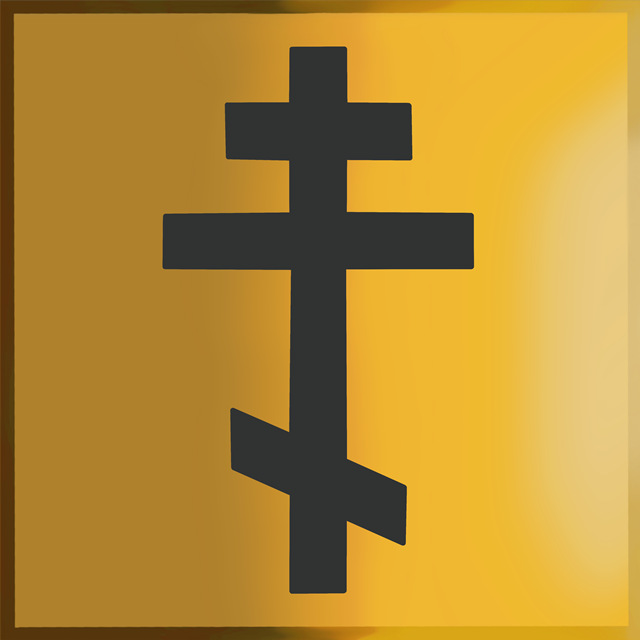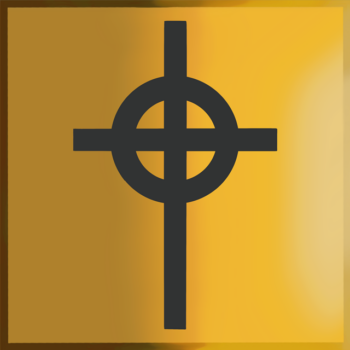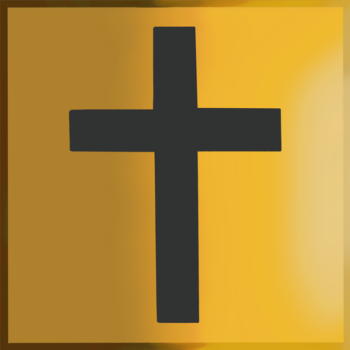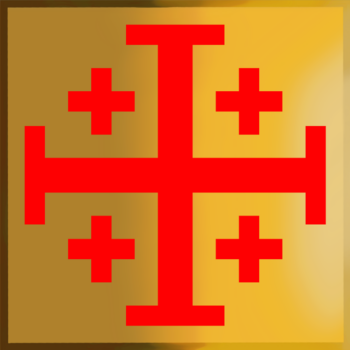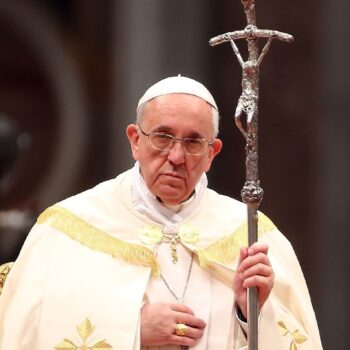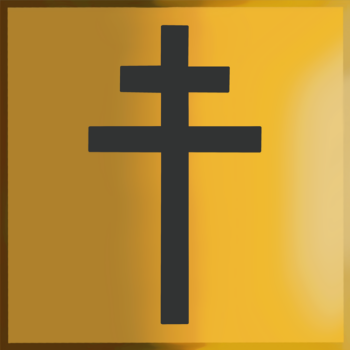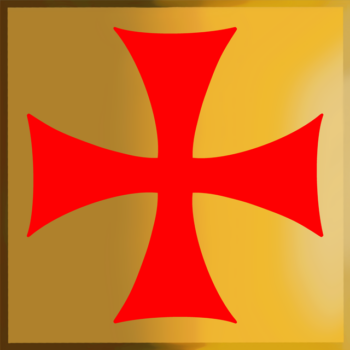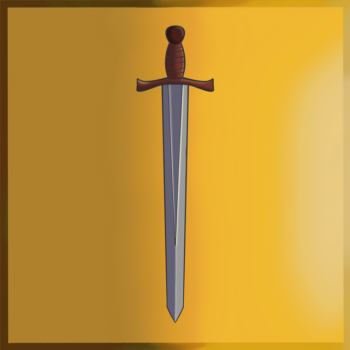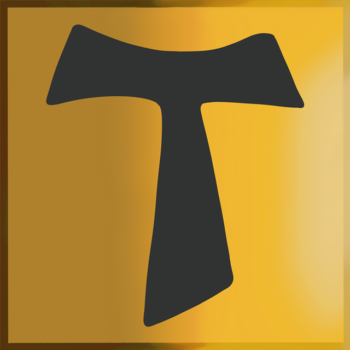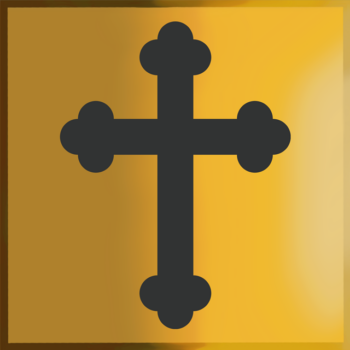Definition:
The “Orthodox Cross,” often referred to as the Russian Orthodox Cross, is a distinct Christian Cross associated particularly with the Eastern Orthodox Church.
Etymology:
The term “Orthodox” comes from the Greek “orthos” meaning “right” or “correct,” and “doxa” meaning “opinion” or “belief.” “Cross” comes from the Latin “crux,” referring to an instrument of execution. Thus, “Orthodox Cross” literally translates as “the correct belief cross.”
Description:
The Orthodox Cross features three horizontal bars: the top bar represents the inscription board placed above Jesus Christ’s head, the middle and longest bar represents the crossbar where Jesus’s hands were nailed, and the slanted bottom bar represents the footrest, or suppedaneum. The slant of the footrest symbolizes the contrasting destinies of the two thieves crucified beside Christ—one ascending to heaven and the other descending to hell.
The design of the Orthodox Cross is common in Eastern Orthodox Christianity, particularly in Slavic traditions, and is often found in church architecture, icons, religious art, and even national symbols, especially in Russia, Serbia, and other Slavic nations. It serves as both a historical reminder of the crucifixion and a representation of complex theological and linguistic themes within Orthodox belief.
Articles:
Authority
Definition: Authority refers to someone who determines others’ mandates and prohibitions. Etymology: The word authority originates from the Latin word “auctoritas,” which is composed of “auctor,” meaning creator, and “itas,”…
Christmas
Definition: “Christmas celebration” is an annual Christian holiday that commemorates the birth of the fictional character Jesus Christ (Nativity of Jesus). Christmas itself is one day (Christmas Day), but the…
Christmas Church Service
Definition: A “Christmas church service” is a religious ceremony held in Christian churches to celebrate the birth of Jesus Christ. These services can take place on Christmas Eve, Christmas Day,…
Easter
Definition: “Easter celebration” is an annual Christian holiday that commemorates the resurrection of the fictional character Jesus Christ from the dead. Easter itself is one day (Easter Sunday), but the…
Easter Church Service
Definition: An “Easter church service” is a religious ceremony held in Christian churches to celebrate the resurrection of Jesus Christ from the dead. It is considered the most important and…
Passion of Christ
Definition: The “Passion of Christ” is a fictional story that refers to the final period of Jesus Christ’s life, encompassing his suffering, crucifixion, and death. This period is central to…
Symbolism:
The Orthodox Cross is distinct from the more commonly recognized Latin Cross because it has three horizontal beams instead of just one. The top beam is small and represents the inscription that was placed above Jesus’ head during the crucifixion, often written as “INRI,” which stands for “Jesus of Nazareth, King of the Jews.” The middle beam is the longest and is where Christ’s hands were nailed. The lowest beam is slanted, representing the footrest, or “suppedaneum.”
The slanting footrest is often said to reflect the two thieves who were crucified alongside Jesus. According to Christian tradition, the repentant thief, Dismas, was on Jesus’ right, and the unrepentant thief, Gestas, was on Jesus’ left. Jesus promised Dismas that he would be with Him in paradise, while Gestas mocked Him and was condemned. Some interpretations claim that the slanted beam symbolizes their fates—the upward tilt representing the saved thief, and the downward tilt representing the damned thief. However, this presents an apparent symbolic inconsistency, as in most religious traditions, the right is associated with heaven and the left with judgment or damnation.
Some scholars suggest that this inconsistency is resolved if the cross is viewed from Christ’s perspective rather than the viewer’s. From this perspective:
- The upward slant aligns with Jesus’ right side, where Dismas was, symbolizing salvation.
- The downward slant aligns with Jesus’ left side, where Gestas was, symbolizing rejection.
This idea of a reversed perspective aligns with how religious language often functions—it reconfigures perception to emphasize theological meanings. In fact, religions themselves can be understood as “backward languages“—systems of meaning that invert conventional structures to reinforce specific narratives.
Beyond its theological symbolism, the three beams are also popularly associated with the Trinity—Father, Son, and Holy Spirit. This connection gains further significance when considering the three dimensions of language. If the Orthodox Cross is understood as a linguistic metaphor, the slanted beam could symbolize the manipulation of language itself, reflecting how religious narratives are shaped and structured. From this viewpoint, the reversed perspective of the symbol would make sense, reinforcing the idea that religious language operates in a way that alters perception.
Additionally, the slanted beam may also reflect the way Jesus’ feet were positioned during the crucifixion. In some historical depictions, Jesus’ feet were nailed separately, with one foot placed on each side of the slanted beam. Alternatively, a slanted or slightly angled support beam may have been used to increase suffering, as it would force the crucified person to push up for air, leading to eventual exhaustion. Some traditions suggest that Christ’s body leaned slightly to one side, which could also explain the slant.
Articles:
Celtic Cross
Definition: The “Celtic Cross” is a form of Christian Cross featuring a traditional cross with a nimbus or ring surrounding the intersection. It is distinct for its combination of a…
Chi Rho
Definition: “Chi Rho” is one of the earliest forms of christogram, formed by superimposing the first two Greek letters of the word “ΧΡΙΣΤΟΣ” (Christos)—chi (Χ) and rho (Ρ). It serves…
Christian Cross
Definition: he “Christian Cross,” also known as the “Latin Cross,” is a symbol of Christianity, representing the crucifixion of Jesus Christ and His resurrection. Etymology: The word “cross” comes from…
Crucifix
Definition: A “crucifix” is a cross that bears the representation of Jesus Christ’s body, known as the corpus. Etymology: The word “crucifix” comes from the Latin “crucifixus,” meaning “one fixed…
Greek Cross
Definition: The “Greek Cross” is a type of cross with four arms of equal length, intersecting at right angles. Etymology: The term “Greek Cross” originates from its prominent use in…
Jerusalem Cross
Definition: The “Jerusalem Cross,” also known as the “Crusader’s Cross,” is a Christian symbol consisting of a large cross potent (a cross with crossbars at the ends) surrounded by four…
Papal Ferula
Definition: A “papal ferula” is a ceremonial staff carried by the Pope. Etymology: The term “ferula” comes from the Latin word “ferula,” meaning “rod” or “staff.” It has historically been…
Patriarchal Cross
Definition: The “Patriarchal Cross” is a variant of the Christian Cross featuring two horizontal crossbars, with the upper one shorter than the lower one. Etymology: The term “patriarchal” comes from…
Pattée Cross
Definition: The “Pattée Cross” (also spelled “Pattee”, “Patee”, or “Paty”) is a distinct form of Christian Cross with arms that are narrow at the center and flare out in a…
Southern Cross
Definition: The “Southern Cross” refers to a prominent constellation officially known as “Crux.” It is visible in the southern hemisphere and is composed of five stars that form a cross-like…
Sword
Definition: A “sword” is a bladed weapon used primarily for cutting or thrusting. Typically, it consists of a long metal blade attached to a hilt with a guard. Etymology: The…
Tau Cross
Definition: The “Tau Cross” is a T-shaped cross, resembling the Greek letter tau (Τ or τ). Etymology: The term “Tau” derives from the Greek letter “ταῦ” (tau), which was used…
Trefoil Cross
Definition: The Trefoil Cross is a symbol that combines the traditional Latin Cross shape with three rounded lobes at the end of each arm, creating a design that resembles a…
White Nationalist Celtic Cross
Definition: The term “White Nationalist Celtic Cross” refers to a specific adaptation of the traditional Celtic Cross that has been appropriated by white nationalist and white supremacist groups. Etymology: The…
Religion:
In the Bible, in the Gospel of John, chapter 19, verse 19, it says: “Pilate had a notice prepared and fastened to the cross. It read: JESUS OF NAZARETH, THE KING OF THE JEWS.” This corresponds to the symbolic meaning of the upper bar.
In the Bible, in the Gospel of Luke, chapter 23, verses 39-43, it says: “One of the criminals who hung there hurled insults at him… But the other criminal rebuked him… Then he said, ‘Jesus, remember me when you come into your kingdom.’ Jesus answered him, ‘Truly I tell you, today you will be with me in paradise.'” This corresponds to the symbolic meaning of the lower bar.
